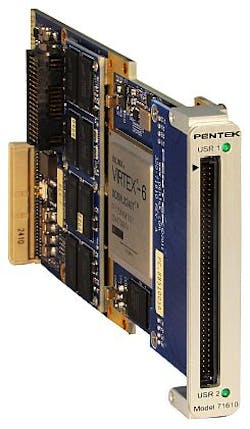FPGA XMC digital I/O module for coding, encryption, and decryption introduced by Pentek
UPPER SADDLE RIVER, N.J., 6 Sept. 2013.Pentek Inc. in Upper Saddle River, N.J., is introducing the model 71610 XMC digital I/O module with low-voltage differential signaling (LVDS) I/O connected to a Virtex-6 field-programmable gate array (FPGA) for encoding/decoding, modulation/demodulation, encryption/decryption and channelization of signals between transmission and reception.
The embedded computing module provides 32 LVDS differential input or output pairs plus LVDS clock, data valid and flow control signals via an easy access front panel 80-pin connector routed to the Virtex-6 FPGA.
LVDS is a general-purpose digital interface operating at high speeds over inexpensive twisted-pair or flat ribbon copper cables, Pentek officials say. It is popular for many common control or data capture applications such as high-speed video, graphics, video camera data transfers and general purpose computer buses.
The standard built-in data capture and data generation facilities of the model 71610 make it an turnkey solution for developing and deploying custom FPGA processing algorithms.
Data can be pulled from devices such as sensors, data converters, custom digital systems or spectrum analyzers and then processed, decoded or formatted in the Virtex-6 FPGA before delivery to the host system processor. Likewise, signals from the host can be processed and formatted by the FPGA before delivery to the LVDS output.
The model 71610 is a VITA 42 XMC switched mezzanine card that can plug into carriers such as VPX, CompactPCI, Advanced Mezzanine Card (AMC) and PCI Express.
The model 71610 supports x4 PCI Express on the primary P15 XMC connector. The secondary P16 XMC connector supports dual 4X or single 8X user-installed gigabit serial interfaces, such as Aurora, PCI Express or Serial RapidIO. The model 71610 has an optional PMC P14 connector with 20 pairs of LVDS connections to the FPGA for custom I/O to the carrier.
Several Virtex-6 FPGA options are available. The Virtex-6 is 2 gigabytes of DDR3 SDRAM provides ample memory buffer space for transient capture, digital delays, DMA packet formation and signal processing algorithms.
For more information contact Pentek online at www.pentek.com.
